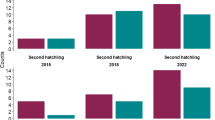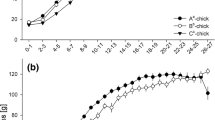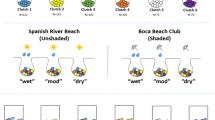Abstract
In many litter-bearing mammals and in a few viviparous reptiles the sex ratio of the entire brood or the sex of the adjacent fetuses induces sex-specific differences in the hatchling’s phenotype. This study examines whether the sex of incubation neighbours affects hatchling characteristics in oviparous common lizards (Lacerta vivipara). Oviparous common lizards lay eggs with thin eggshells and, therefore, are an optimal model organism for studying the effects of hormone leakage among developing embryos since the strongest evidence for prenatal sex ratio effects on offspring development comes from viviparous populations of the same species. Groups of three eggs were incubated together and were categorised according to the sex of the resulting hatchlings as either homosex (three hatchlings of the same sex) or heterosex (one male or one female hatchling plus two siblings of the opposite sex). Hatchlings incubated adjacent to siblings of the same sex had larger body mass and body condition. Males tended to have lower ventral scale counts when incubated with other males. Conversely, females tended to have more ventral scales when incubated with other females, indicative of a more feminised phenotype. There was also a significant interaction between hatchling sex and incubation environment with respect to the length of the fourth digit of the hindlimb, likely indicative of masculinisation in heterosex females. This study suggests steroid diffusion between adjacent eggs in a minimally manipulative experiment and provides the first evidence for developmental effects of the exogenous hormonal environment in near natural conditions in an oviparous amniote. Implications of these results for the evolution of within-clutch sex ratio are discussed.



Similar content being viewed by others
References
Austin HB (1988) Differentiation and development of the reproductive system in the iguanid lizard Sceloporus undulatus. Gen Comp Endocrinol 72:351–363
Board RG, Sparks NHC (1991) Shell structure and formation in avian eggs. In: Deeming DC, Ferguson MWJ (eds) Egg incubation: its effects on embryonic development in birds and reptiles. Cambridge University Press, Cambridge, pp 71–86
Boulenger GA (1920) Monograph of the lacertidae, vol I. Trustees of the British Museum (Natural History), London
Braña F (1996) Sexual dimorphism in lacertid lizards: male head increase vs. female abdomen increase? Oikos 75:511–523
Braña F, Bea A, Arrayago MJ (1991) Egg retention in lacertid lizards: relationships with reproductive ecology and the evolution of viviparity. Herpetologica 47:218–226
Brown WM, Hines M, Fane BA, Breedlove SM (2002) Masculinized finger length patterns in human males and females with congenital adrenal hyperplasia. Horm Behav 42:380–386
Bull JJ (1980) Sex determination in reptiles. Q Rev Biol 55:3–21
Burley NT, Foster VS (2004) Digit ratio varies with sex, egg order and strength of mate preference in zebra finches. Proc R Soc B Biol Sci 271:239–244
Charnov EL (1982) The theory of sex allocation. Princeton University Press, Princeton
Clark MM, Galef BG (1995) Prenatal influences on reproductive life history strategies. Trends Ecol Evol 10:151–153
Cox RM, John-Alder H (2005) Testosterone has opposite effects on male growth in lizards (Sceloporus spp.) with opposite patterns of sexual size dimorphism. J Exp Biol 208:4679–4687
Cox RM, Skelly SL, John-Alder HB (2005) Testosterone inhibits growth in juvenile male eastern fence lizards (Sceloporus undulatus): implications for energy allocation and sexual size dimorphism. Physiol Biochem Zool 78:531–545
Crews D (1996) Temperature-dependent sex determination: the interplay of steroid hormones and temperature. Zool Sci 13:1–13
De Fraipont M, Clobert J, John-Alder H, Meylan S (2000) Increased prenatal maternal corticosterone promotes philopatry of offspring in common lizards Lacerta vivipara. J Anim Ecol 69:404–413
Doddamani LS (2005) Histoenzymological studies on embryonic and posthatching development of the ovary in the tropical oviparous lizard, Calotes versicolor. J Morphol 222:1–10
Doddamani LS (2006) Differentiation and development of testis in the oviparous lizard, Calotes versicolor (Daud.). J Exp Zool A 305:299–308
Dufaure JP, Hubert J (1961) Table de developement du lizard vivipare: Lacerta (Zootoca) vivipara Jacquin. Arch Anat Microsc Morphol Exp 50:309–328
Dufty AM, Clobert J, Møller AP (2002) Hormones, developmental plasticity and adaptation. Trends Ecol Evol 17:190–196
Even MD, Dhar MG, vom Saal FS (1992) Transport of steroids between fetuses via amniotic fluid in relation to the intrauterine position phenomenon in rats. J Reprod Fertil 96:709–716
Frank SA (1990) Sex allocation theory for birds and mammals. Annu Rev Ecol Syst 21:13–55
Gvoždík L, Van Damme R (2003) Evolutionary maintenance of sexual dimorphism in head size in the lizard Zootoca vivipara: a test of two hypotheses. J Zool 259:7–13
Harlow PS (1996) A harmless technique for sexing hatchling lizards. Herpetol Rev 27:71–72
Heulin B, Ghielmi S, Vogrin N, Surget-Groba Y, Guillaume CP (2002) Variation in eggshell characteristics and in intrauterine egg retention between two oviparous clades of the lizard Lacerta vivipara: insights into the oviparity–viviparity continuum in Squamates. J Morphol 252:255–262
Janzen FJ, Paukstis GL (1991) Environmental sex determination in reptiles: ecology, evolution and experimental design. Q Rev Biol 66:149–179
Ji X, Braña F (1999) The influence of thermal and hydric environments on embryonic use of energy and nutrients in the wall lizard (Podarcis muralis). Comp Biochem Physiol A 124:205–213
Kaijser M, Granath F, Jacobsen G, Cnattingius S, Ekbom A (2000) Maternal pregnancy estriol levels in relation to anamnestic and fetal anthropometric data. Epidemiology 11:315–319
Kinsley C, Miele J, Wagner CK, Ghiraldi L, Broida J, Svare B (1986) Prior intrauterine position influences body weight in male and female mice. Horm Behav 20:201–211
Kratochvíl L, Kubička L, Landová E (2006) Yolk hormone levels in the synchronously developing eggs of Paroedura picta, a gecko with genetic sex determination. Can J Zool 84:1683–1687
Lindström J (1999) Early development and fitness in birds and mammals. Trends Ecol Evol 14:343–348
Lovern MB, Wade J (2001) Maternal plasma and egg yolk testosterone concentrations during embryonic development in green anoles (Anolis carolinensis). Gen Comp Endocrinol 124:226–235
Lovern MB, Wade J (2003a) Yolk testosterone varies with sex in eggs of the lizard, Anolis carolinensis. J Exp Zool A 295:206–210
Lovern MB, Wade J (2003b) Sex steroids in green anoles (Anolis carolinensis): uncoupled maternal plasma and yolking follicle concentrations, potential embryonic steroidogenesis, and evolutionary implications. Gen Comp Endocrinol 134:109–115
Lummaa V, Petay JE, Russell AF (2007) Male twins reduce fitness of female co-twins in humans. Proc Natl Acad Sci USA 104(26):10915–10921
McFadden D (1993) A masculinizing effect on the auditory systems of human females having male co-twins. Proc Natl Acad Sci USA 90(24):11900–11904
Osypka NM, Arnold SJ (2000) The developmental effect of sex ratio on a sexually dimorphic scale count in the garter snake Thamnophis elegans. J Herpetol 34:1–5
Packard MJ, DeMarco VG (1991) Eggshell structure and formation in eggs of oviparous reptiles. In: Deeming DC, Ferguson MWJ (eds) Egg incubation: its effects on embryonic development in birds and reptiles. Cambridge University Press, Cambridge, pp 53–69
Petridou E, Panagiotopoulou K, Katsouyanni K, Spanos E, Trichopoulos D (1990) Tobacco smoking, pregnancy estrogens, and birth weight. Epidemiology 1:247–250
Putz DA, Gaulin SJC, Sporter RJ, McBurney DH (2004) Sex hormones and finger length: what does 2D:4D indicate? Evol Hum Behav 25:182–199
Radder R, Ali S, Shine R (2007) Offspring sex is not related to maternal allocation of yolk steroids in the lizard Bassiana duperreyi (Scincidae). Physiol Biochem Zool 80:220–227
Rhen T, Crews D (2002) Variation in reproductive behaviour within a sex: neural systems and endocrine activation. J Neuroendocrinol 14:517–531
Romano M, Rubolini D, Martinelli R, Bonisoli A, Saino N (2005) Experimental manipulation of yolk testosterone affects digit length ratios in the ring-necked pheasant (Phasianus colchicus). Horm Behav 48:342–346
Rubolini D, Pupin F, Sacchi R, Gentilli A, Zuffi MAL, Galeotti P, Saino N (2006) Sexual dimorphism in digit length ratios in two lizard species. Anat Rec A 288:491–497
Shadrix CA, Crotzer DR, McKinney SL, Stewart JR (1994) Embryonic growth and calcium mobilization in oviposited eggs of the scincid lizard, Eumeces fasciatus. Copeia 1994:493–498
Uller T (2003) Viviparity as a constraint on sex-ratio evolution. Evolution 57:927–931
Uller T, Olsson M (2003a) Prenatal sex ratios influence sexual dimorphism in a reptile. J Exp Zool A 295:183–187
Uller T, Olsson M (2003b) Prenatal exposure to testosterone increases ectoparasite susceptibility in the common lizard (Lacerta vivipara). Proc R Soc Lond B 270:1867–1870
Uller T, Olsson M (2006) Direct exposure to corticosterone during embryonic development influences behaviour in an ovoviviparous lizard. Ethology 112:390–397
Uller T, Massot M, Richard M, Lecomte J, Clobert J (2004) Long-lasting fitness consequences of prenatal sex ratio in a viviparous lizard. Evolution 58:2511–2516
Uller T, Meylan S, de Fraipont M, Clobert J (2005) Is sexual dimorphism affected by the combined action of prenatal stress and sex ratio? J Exp Zool A 303:1110–1114
Vleck D (1991) Water economy and solute regulation of reptilian and avian embryos. In: Deeming DC, Ferguson MWJ (eds) Egg incubation: its effects on embryonic development in birds and reptiles. Cambridge University Press, Cambridge, pp 245–259
vom Saal FS (1989) Sexual differentiation in litter-bearing mammals: influence of sex of adjacent fetuses in utero. J Anim Sci 67:1824–1840
vom Saal FS, Dhar MG (1992) Blood flow in the uterine loop artery and loop vein is bidirectional in the mouse: implications for transport of steroids between fetuses. Physiol Behav 52:163–171
Acknowledgements
I am grateful to Félix González for help with collecting the animals and for assistance in the laboratory and to Tania Iglesias for assistance in measuring hatchlings. Francis Juanes and Kiersten Madden provided valuable comments on the manuscript. This work was supported by grants from the Spanish MEC, projects CGL2004-00262 and CGL2007-60187/BOS. Lizards were collected under permits EP 115/2003 (Consejería de Medio Ambiente; Junta de Castilla y León) and reg. 2003-6583 (Consejería de Medio Ambiente; Gobierno del Principado de Asturias). This study was approved by the Ethical Committee of the University of Oviedo.
Author information
Authors and Affiliations
Corresponding author
Additional information
Communicated by Anssi Laurila.
Rights and permissions
About this article
Cite this article
Braña, F. Sex of incubation neighbours influences hatchling sexual phenotypes in an oviparous lizard. Oecologia 156, 275–280 (2008). https://doi.org/10.1007/s00442-008-0996-z
Received:
Accepted:
Published:
Issue Date:
DOI: https://doi.org/10.1007/s00442-008-0996-z




